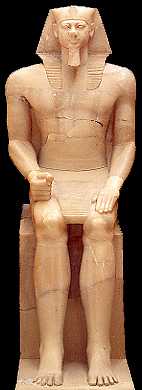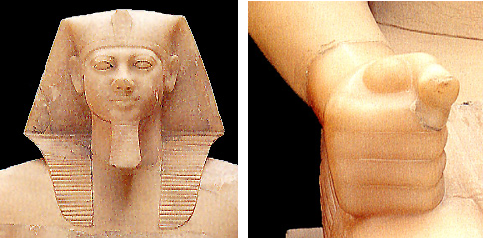
The restored colossus.
Source: Arts of Ancient Egypt, pp. 80-81.
In 1907, different fragments of this colossal alabaster statue were found in a pit in Mykerinos' mortuary temple at Giza. Other fragments were uncovered in an adjacent corridor and the beautifully intact head, finally, in a robber's trench nearby. The fact that several fragments were found at different locations has led to believe that the statue was deliberately destroyed, perhaps by the same robbers who dug the trench where the head was found.
With its 2m35 in height, it was one of the largest colossi dated to the Old Kingdom to have been found thus far. Although it was not inscribed, the archaeological context makes it clear that this statue represents Mykerinos and that it was once part of his funerary cult. The identification of this colossus can further be confirmed by its facial traits which are very similar to the traits of other statues of that same king. This, however, does not imply that this or the other statues represented an actual portrait of Mykerinos.
The king is seated on a throne. He wears the usual nemes head dress, which, along with the uraeus and the false beard, is a sign of his royalty. For unknown reasons, the shoulders and torso are unusually large, making the head look quite small in comparison. This may have been done with the intent to stress the king's omnipotence. His right hand is clasped around a piece of cloth.

Detail of the head and hand of the Mykerinos colossus.
Source: Arts of Ancient Egypt, pp. 80-81.
It is now one of the many statues of Mykerinos on display at the Boston Museum of Fine Arts.
